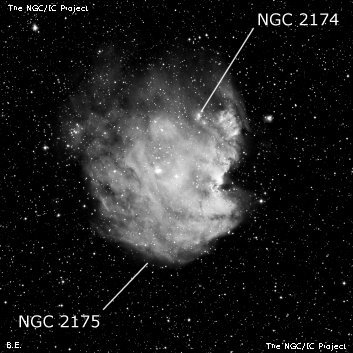
Carl Christian Bruhns discovered NGC 2175 = Au 21 in 1857 using a comet-seeker at the Berlin Observatory. His position corresponds with mag 7.6 HD 42088. Arthur Auwers described this nebula on 24 Feb 1861 with the 6" Heliometer at Konigsberg Observatory as "a considerable area of milky, faint light, extended about 8' north-south and 25' east-west. In the brightest part is the 8m star." Heinrich d'Arrest made 3 observations using the 11-inch refractor at Copenhagen in Jan 1865 and wrote "the extraordinarily large, faint nebula is one of the objects which are difficult to see with higher magnification. It took a long time to find it." (translations from Wolfgang Steincke). E.E. Barnard also commented "In the finder (3 1/4-inch) [of the 12-inch Lick refractor], the 8m star is seem to be surrounded by a group of small stars - the whole being a loose cluster. The cluster is enveloped in feeble nebulosity." See my notes on NGC 2174.
400/500mm - 17.5" See description for NGC 2174. Although the scattered group of stars involved with the HII region is identified as NGC 2175, the NGC description (from Auwers and Bruhns) does not refer to a cluster but rather a "*8m in neb (Auw No 21)". The position given is 10' S of NGC 2174 and 16 tsec east. But in the IC 2 notes and correction, Dreyer gives a correction in RA from Bigourdan to 06 01 32. This places NGC 2175 at 06 09 52 +20 29.1 (2000) and is just 1' S of the brightest section of the nebula (about 3' ENE of mag 8 SAO 78049). The scattered group is catalogued as Cr 84.
Notes by Steve Gottlieb